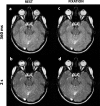Dynamic Imaging of the Eye, Optic Nerve, and Extraocular Muscles With Golden Angle Radial MRI
- PMID: 28813574
- PMCID: PMC5559179
- DOI: 10.1167/iovs.17-21861
Dynamic Imaging of the Eye, Optic Nerve, and Extraocular Muscles With Golden Angle Radial MRI
Erratum in
-
Erratum.Invest Ophthalmol Vis Sci. 2017 Sep 1;58(11):4799. doi: 10.1167/iovs.17-22948a. Invest Ophthalmol Vis Sci. 2017. PMID: 28973336 Free PMC article. No abstract available.
Abstract
Purpose: The eye and its accessory structures, the optic nerve and the extraocular muscles, form a complex dynamic system. In vivo magnetic resonance imaging (MRI) of this system in motion can have substantial benefits in understanding oculomotor functioning in health and disease, but has been restricted to date to imaging of static gazes only. The purpose of this work was to develop a technique to image the eye and its accessory visual structures in motion.
Methods: Dynamic imaging of the eye was developed on a 3-Tesla MRI scanner, based on a golden angle radial sequence that allows freely selectable frame-rate and temporal-span image reconstructions from the same acquired data set. Retrospective image reconstructions at a chosen frame rate of 57 ms per image yielded high-quality in vivo movies of various eye motion tasks performed in the scanner. Motion analysis was performed for a left-right version task where motion paths, lengths, and strains/globe angle of the medial and lateral extraocular muscles and the optic nerves were estimated.
Results: Offline image reconstructions resulted in dynamic images of bilateral visual structures of healthy adults in only ∼15-s imaging time. Qualitative and quantitative analyses of the motion enabled estimation of trajectories, lengths, and strains on the optic nerves and extraocular muscles at very high frame rates of ∼18 frames/s.
Conclusions: This work presents an MRI technique that enables high-frame-rate dynamic imaging of the eyes and orbital structures. The presented sequence has the potential to be used in furthering the understanding of oculomotor mechanics in vivo, both in health and disease.
Figures








References
-
- Eggert T. . Eye movement recordings: methods. Dev Ophthalmol. 2007; 40: 15– 34. - PubMed
-
- Miller JM, Robinson DA. . A model of the mechanics of binocular alignment. Comput Biomed Res. 1984; 17: 436– 470. - PubMed
-
- Kono R, Clark RA, Demer JL. . Active pulleys: magnetic resonance imaging of rectus muscle paths in tertiary gazes. Invest Ophthalmol Vis Sci. 2002; 43: 2179– 2188. - PubMed
-
- Schutte S, van den Bedem SP, van Keulen F, van der Helm FC, Simonsz HJ. . A finite-element analysis model of orbital biomechanics. Vision Res. 2006; 46: 1724– 1731. - PubMed
Publication types
MeSH terms
Grants and funding
LinkOut - more resources
Full Text Sources
Other Literature Sources
Medical

